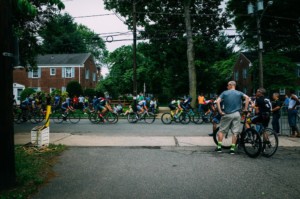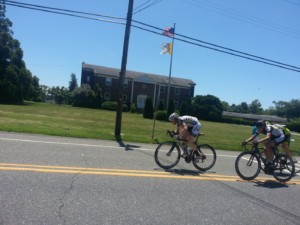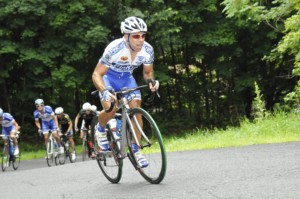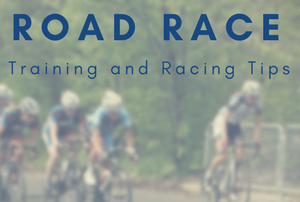A cycling road race is one of the purest forms of head-to-head competition there is. It's a test of strength, cunning, endurance and a little bit of luck. It's also one of the most rewarding aspects of riding a bicycle that you can find. But what should you do if you want to start road racing? Do you need to buy a fancy bike and spend your life training? Or can you just pin on a number and take your chances?
Well, you can do either.
In this episode of the Tailwind Coaching Podcast, I'll teach you what the essential components of a road race training plan are. You'll learn what different kinds of races are and what kind of training you need to handle the physical demands of a variety of road races. I'll even give you some road race tips to help improve your odds of landing on the podium.
Are you ready to learn how to make the most out of your road race training? If so, click through the jump and listen for tips on dominating your next road race.
Podcast: Play in new window | Download (Duration: 48:11 — 36.7MB)
Subscribe: RSS
 What is a road race?
What is a road race?
A road race is a term given to a race which occurs on roads (obviously) and follows a specific format. This format involves a mass start where all riders begin together and are scored by finishing order. Whoever crosses the line first wins. Road races come in a wide variety of race course formats. You have circuit races, which cover multiple laps of a specific length circuit. There are “point to point” races in which the starting area and finish area are in completely different places (most traditional European professional races are this format.) There are also standard “out and back” races where the start and finish are in the same location, but the race covers a larger distance and doesn't loop back over the same circuit several times (the Battenkill gravel race is a great example of this.)
The one common thread among road races is the mass start, finish order race style. The terrain is everything from flat to hilly, smooth pavement to gravel roads and anything in between. The general fitness requirements for road racing success are pretty much the same. Each specific race course will demand specific skills, but the general principles are all the same.
Let's take a look at what you need to be successful in road races.
What's in a road race training plan?
A good road race training program is designed to make you a well rounded, competitive racer. There are a few components to a program that can make or break your fitness, so make sure these are included. If you want an easy solution, all of my training programs include some variations of these concepts. If you want to build your own program, you'll need these to ensure you're fit and fast:
Muscular endurance to last the distance
I've talked about muscular endurance multiple times in the past. Muscular endurance is simply the ability for your body to handle increased time under tension, and it's usually the basis of most training programs. In this case, muscular endurance isn't the most important skill you'll need to be successful. In most road races (if you race intelligently) you'll spend tons of time at low intensities. You'll need enough muscular endurance to handle the “hot parts” of the race but you shouldn't be making huge efforts over and over and over again.
Without those huge repeated efforts, you shouldn't need as much muscular endurance as a criterium race or a time trial, for example. You'll certainly need to push those big gears, but you shouldn't be constantly under pressure. With that in mind, you should still consider including a significant amount of muscular endurance training in your program. Multiple intervals of 20-45 minutes at 65-75 RPM will help you build the fatigue resistance you need to survive a long road race. You can also combine those muscular endurance intervals with some sweetspot intensity training and build your aerobic endurance at the same time.
 FTP and VO2 max intervals let you spend more time below threshold
FTP and VO2 max intervals let you spend more time below threshold
Just like in time trial or criterium training, the more you build VO2 max and raise your fitness ceiling, the less time you'll spend above threshold. This is important in a road race to ensure you're not wasting precious anaerobic capacity on small accelerations. Moving through the field and coping with changes in the pace of the peloton can take its toll on your energy reserves. If you build that big VO2 max capacity and the Functional Threshold Power to match, you'll have no trouble coping with those accelerations. Conversely, if you lack sufficient FTP development, you'll struggle to deal with repeated accelerations in the peloton.
It's worth mentioning that you need to take a look at aerobic endurance development in this case. Without sufficient aerobic endurance, you'll be fatigued by the end of the race and unable to make moves when they count. It doesn't matter how good your VO2 max or FTP is. Unless you're overall fatigue resistance is built up properly, you're going to suffer by the end of the race.
To build that FTP and VO2 level fitness, add a variety of VO2 max intervals and FTP work to your program. 3-8 minute VO2 efforts combined with 20-40 minutes of Functional Threshold Power work is a great start.
Increase neuromuscular efficiency to reduce energy expenditure
It's been said over and over. If you want to go faster, be more efficient. The more efficient you are at using your energy to push the pedals, the more power will go into those pedals.
You see, every muscle is comprised of a whole bunch of muscle fibers, which are organized into bundles called “fascicles.” When you want to move your legs, your brain sends a signal to your muscles telling a bunch of those fascicles to contract at about the same time to move your joints. The first few times you pedal a bike, those contractions are pretty uncoordinated. When your muscle fascicles don't contract together, they end up fighting each other a little bit, resulting in some lost efficiency. You actually lose potential power because your muscles don't work together very well. So increasing how coordinated your muscle contractions are, you'll save energy for when it really counts.
To build that efficiency, you'll need some specific interval work. Superspins (130 RPM please!), spinups from really low RPM to really high (best done downhill) and single leg drills will help you learn how to pedal more efficiently.
Key skills to help ensure road racing success!
Just because you've spent a ton of time training doesn't mean that fitness will translate into wins. Road races require tactical cunning, finishing skills and a whole lot of luck to be successful. Keep these skills in mind if you want to raise your chances of standing on the podium when the day is over:
 Race winner intervals
Race winner intervals
“Race winners” are a special kind of interval that mimics the kind of efforts needed to break away from the field and win a race. Hence the name, “race winner.” It's a kind of interval that simulates the hard acceleration needed to get a gap, the VO2 max level effort necessary to hold it and the finishing kick necessary to blow someone off your wheel. On top of that, it's a fantastic way to force your body to burn a bunch of anaerobic capacity and increase your VO2 max capacity. By pushing your body to produce power in that depleted state, your body is forced to learn how to tap into deep anaerobic reserves and increase your aerobic machinery.
To execute these intervals, simply start with a solid 30-second effort of around 150% of threshold, continue hard riding for 3-8 minutes of VO2 max effort and finish it off with a maximum power sprint effort. The intensity of the VO2 max effort will depend on how long the actual middle effort of the interval is (see below). Repeat 3-5 times per session.
VO2 max intervals
Vo2 max intervals are your bread and butter for increasing late game success in a road race. Once the hammer goes down, you'll need plenty of VO2 max intensity to handle the big accelerations that fill the final miles of a road race. If you want to handle those high-intensity efforts, prepare to spelunk into the pain cave.
VO2 max intervals are a variety of high-intensity intervals that stimulate your body to build more advanced aerobic machinery. In the link included, I've given you a couple of intervals like the 3221 workout and the 333 workout. Those are very specific kinds of intervals that are designed to stimulate very specific physiological gains. In essence, they are similar to a race winner interval, forcing you to exhaust your anaerobic capacity and build your aerobic system.
Pure VO2 max intervals are simply 3-8 minute efforts of 110% to 120% of FTP. The longer the interval, the lower the overall intensity you'll be able to sustain. Depending on the length of the interval, repeat between 3 and 9 times with equal rest between.
Interval repeatability
I talked about repeatability in my criterium training and racing tips podcast. Road races aren't much different, but the repeatability aspect comes into play much later in the game. You're also probably going to be pretty tired by the time the attacks start to fly.
Keeping this in mind, repeatability is a two part process for a road race. First of all, standard repeatability intervals such as 20 seconds on, 10 seconds off for 5 minutes and 3×3 minutes at 130% of FTP will help your body adapt to recovering after hard efforts. Once you've built up some recovery potential, you can start performing those repeatability intervals while you're fatigued. After a long ride or following a significant amount of training stress, perform those repeatability intervals. They'll be much tougher when your body is already fatigued.
One of my favorite combinations for repeatability training involves 3 or 4 8 minute VO2 intervals followed by a couple sets of tabata type intervals (20 on, 10 off.)
Marginal gains and tips to race a road race effectively
Successfully completing a road race requires skill, luck and plenty of critical thinking. You need to stay quiet, inconspicuous and save as much energy as possible if you hope to make the podium. It doesn't hurt to have a couple of additional percentage points of fitness to help out though. If you're looking for that final edge, I've got a couple of things to tip the scales in your favor.
Efficiency is the key to success
If you want to be better during a road race, you'll need to be smarter than the rest of the field. The old saying goes that “the smartest rider wins the race, not the strongest.” This applies to everything from track races to Tour de France stages. By riding smarter than the guy next to you, victory is much easier to achieve.
The biggest thing you can do to ride smarter is to position yourself correctly in the field. Stay near the front 1/3 of the field and keep your nose out of the wind. That's worth repeating. Stay out of the wind! The longer you sit in the wind, the more energy you'll be spending and the less you'll have to spend later in the race. Note that this doesn't mean you should sit in and never put your face in the wind. If a move is getting away that will prevent you from winning, be prepared to spend some energy in the chase. It's better to spend some energy and have a sliver of a chance at the win than to have no chance at all.
Speaking of winning, you can't win unless you have a plan. Building a plan for a road race could be a podcast in itself, but to put it simply, you'll need to plan based on your strengths and weaknesses. Your A plan should be your best chance of winning based on your strengths. Plan B should be based on your next biggest strength. Your C plan should be based on another strength, and the D plan should be based on the terrain and last ditch effort. It may just be a case of hoping for the best and making a hero move to win by surprise.
 Only move if it helps you win
Only move if it helps you win
If you're keeping yourself hidden, you're probably not making any silly moves off the front. You still need to move through the field. Sometimes you need to cover breakaways. No matter what move you have to make, always ask yourself this one question: “Will this move ultimately help me win this race?” Does moving up right now help you win later? Can you be in a better position coming into the final laps if you spend energy now? Does chasing that dangerous break make sense because it might go the distance? Will surfing this particular wheel give me a better chance at sprinting for the win?
Never make moves that have no purpose. Calculate each move to fit within your A, B, C, or D plan. If that move doesn't make sense for any of those, don't do it!
Know who you're racing against
You can't win a race if you're not sure who's in the peloton with you. No discussion of road racing tips would be complete without reminding you to know your opponents. Take a look at their racing history, where they placed and the terrain of the races they've done well in. If you find yourself in a race with someone like that, plan to go with a move that plays to their strengths. For example, if they're a good rouler and you're racing over an undulating course, go with moves they make. If they're a solid climber and you're racing over a hilly course, go with their moves on the climbs. Should you need to wait until the end of the race, find the wheel of a good sprinter and follow it into the finish line.
Let the race profile dictate how you use your strengths
Ultimately the race course dictates how you use your strengths. If you have a high power to weight ratio, you'll make moves when the road tilts upwards. Sprinters will want to wait for the end of the race. Rouleurs will want to break away and try to win alone. Flat races tend towards riders with huge raw wattage and great aerodynamics.
Study the race profile and figure out how your abilities fit into it. If you're entering a race that doesn't necessarily suit your strengths, start trying things out. For example, rouleurs might try to escape the field on a little rise and hold them off on a flat run in. Sprinters might use a flat final corner as a launching pad into the last 500 meters.
Try different things, learn where you can be strong, cover your weaknesses and you'll soon be a regular on the podium.
With all these tips in mind, it's time to get out there and start training for your next road race. If you want that planned out for you, check out my downloadable training plans to get a jump on your fitness and take your road racing to the next level.
Don't forget to support the podcast by leaving a review on iTunes or doing your shopping through one of my affiliates!
